Arthritis of the Hip: In-depth Information, X-ray Insights, and Beyond
In the world of joint disorders, hip arthritis is a common and debilitating condition, particularly among the elderly. This article aims to shed light on the diagnosis, treatment, and surgical interventions for severe hip osteoarthritis.
Severe hip osteoarthritis is characterised by several tell-tale signs, including pain, especially in the groin that may radiate to the buttocks, thigh, or knee, joint stiffness that worsens in the morning or after inactivity, and a reduced range of motion. Patients often find it difficult to perform daily activities like sitting cross-legged, putting on shoes, or washing feet, and may develop a limp due to pain and stiffness.
Diagnosis of severe hip osteoarthritis is confirmed through imaging techniques such as X-rays and sometimes MRI, which reveal the joint damage. X-rays, in particular, show the effects of the condition, such as deformity in the bones, spur formation, and the absence of cartilage.
Treatment options vary by the severity of the condition. For mild to moderate cases, conservative management is the norm. This includes weight loss to reduce joint load, physiotherapy and exercises, including water-based activities, to maintain joint function and strength, pain relief with analgesics, and heat therapy to relieve stiffness and improve circulation.
However, when conservative measures fail, surgical treatment becomes necessary. Total hip replacement (arthroplasty) is the most effective treatment for severe hip osteoarthritis, often providing pain relief and improved function. The procedure involves removing the damaged ball-and-socket joint and replacing it with a plastic, metal, or ceramic joint. The expected lifespan following the procedure is significant, often exceeding 20 years.
Another surgical option is hip resurfacing, a procedure suitable for younger individuals due to its ease of revision compared to total hip replacement. Hip resurfacing entails removing damaged cartilage and bone and replacing them with a metal shell, while capping the ball of the thigh bone with a metal covering.
It's important to note that hip arthroscopy may treat related hip injuries but is not effective for arthritis itself.
In severe cases of hip arthritis, the surrounding muscles may weaken and get smaller, increasing strain on the joint and making movement challenging.
Research indicates that total hip replacement is highly effective in reducing pain and restoring function. The results from hip resurfacing are comparable to those of standard hip replacement.
In conclusion, severe hip osteoarthritis can significantly impact one's quality of life, causing pain and loss of function. When non-surgical treatments are insufficient, hip replacement surgery is the preferred and successful intervention.
Science has made remarkable advances in the diagnosis and treatment of medical conditions such as chronic diseases like osteoarthritis, with severe hip osteoarthritis being one of the most prevalent. Chronic kidney disease and other health and wellness concerns should not be overlooked as they can coexist with chronic diseases like osteoarthritis. Fitness and exercise play a crucial role in managing osteoarthritis symptoms, as they help maintain joint function, relieve stiffness, and improve circulation.




